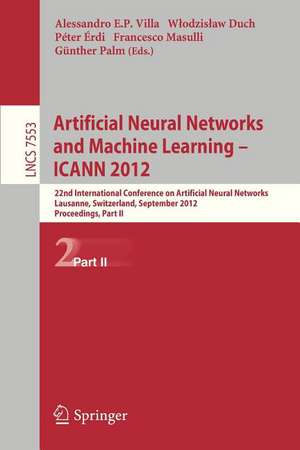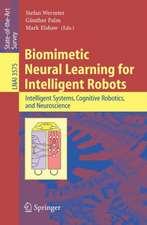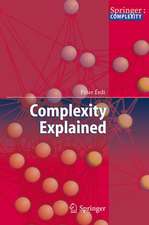Artificial Neural Networks and Machine Learning -- ICANN 2012: 22nd International Conference on Artificial Neural Networks, Lausanne, Switzerland, September 11-14, 2012, Proceedings, Part II: Lecture Notes in Computer Science, cartea 7553
Editat de Alessandro Villa, Włodzisław Duch, Péter Érdi, Francesco Masulli, Günther Palmen Limba Engleză Paperback – 8 aug 2012
Din seria Lecture Notes in Computer Science
- 20%
 Preț: 1061.55 lei
Preț: 1061.55 lei - 20%
 Preț: 307.71 lei
Preț: 307.71 lei - 20%
 Preț: 438.69 lei
Preț: 438.69 lei - 20%
 Preț: 579.30 lei
Preț: 579.30 lei -
 Preț: 410.88 lei
Preț: 410.88 lei - 17%
 Preț: 427.22 lei
Preț: 427.22 lei - 20%
 Preț: 596.46 lei
Preț: 596.46 lei - 15%
 Preț: 448.04 lei
Preț: 448.04 lei - 20%
 Preț: 353.50 lei
Preț: 353.50 lei -
 Preț: 389.49 lei
Preț: 389.49 lei - 20%
 Preț: 309.90 lei
Preț: 309.90 lei - 20%
 Preț: 645.28 lei
Preț: 645.28 lei - 20%
 Preț: 763.23 lei
Preț: 763.23 lei - 15%
 Preț: 580.46 lei
Preț: 580.46 lei - 20%
 Preț: 310.28 lei
Preț: 310.28 lei - 20%
 Preț: 655.02 lei
Preț: 655.02 lei - 20%
 Preț: 1183.14 lei
Preț: 1183.14 lei - 20%
 Preț: 340.32 lei
Preț: 340.32 lei -
 Preț: 449.57 lei
Preț: 449.57 lei - 20%
 Preț: 591.51 lei
Preț: 591.51 lei - 18%
 Preț: 938.83 lei
Preț: 938.83 lei - 20%
 Preț: 337.00 lei
Preț: 337.00 lei - 20%
 Preț: 649.50 lei
Preț: 649.50 lei - 20%
 Preț: 607.40 lei
Preț: 607.40 lei - 20%
 Preț: 1414.79 lei
Preț: 1414.79 lei - 20%
 Preț: 1024.44 lei
Preț: 1024.44 lei - 20%
 Preț: 583.40 lei
Preț: 583.40 lei - 20%
 Preț: 453.32 lei
Preț: 453.32 lei - 20%
 Preț: 575.49 lei
Preț: 575.49 lei - 20%
 Preț: 1075.26 lei
Preț: 1075.26 lei - 20%
 Preț: 585.88 lei
Preț: 585.88 lei - 20%
 Preț: 825.93 lei
Preț: 825.93 lei - 17%
 Preț: 360.20 lei
Preț: 360.20 lei - 20%
 Preț: 763.23 lei
Preț: 763.23 lei - 20%
 Preț: 340.32 lei
Preț: 340.32 lei - 20%
 Preț: 504.58 lei
Preț: 504.58 lei - 20%
 Preț: 369.13 lei
Preț: 369.13 lei - 20%
 Preț: 580.93 lei
Preț: 580.93 lei - 20%
 Preț: 343.62 lei
Preț: 343.62 lei - 20%
 Preț: 350.21 lei
Preț: 350.21 lei - 20%
 Preț: 583.40 lei
Preț: 583.40 lei - 20%
 Preț: 583.40 lei
Preț: 583.40 lei - 15%
 Preț: 438.59 lei
Preț: 438.59 lei - 20%
 Preț: 341.95 lei
Preț: 341.95 lei - 20%
 Preț: 238.01 lei
Preț: 238.01 lei - 20%
 Preț: 538.30 lei
Preț: 538.30 lei
Preț: 348.06 lei
Preț vechi: 435.08 lei
-20% Nou
Puncte Express: 522
Preț estimativ în valută:
66.60€ • 71.22$ • 55.53£
66.60€ • 71.22$ • 55.53£
Carte tipărită la comandă
Livrare economică 17 aprilie-01 mai
Preluare comenzi: 021 569.72.76
Specificații
ISBN-13: 9783642332654
ISBN-10: 364233265X
Pagini: 616
Ilustrații: XXVIII, 590 p. 172 illus.
Dimensiuni: 155 x 235 x 32 mm
Greutate: 0.85 kg
Ediția:2012
Editura: Springer Berlin, Heidelberg
Colecția Springer
Seriile Lecture Notes in Computer Science, Theoretical Computer Science and General Issues
Locul publicării:Berlin, Heidelberg, Germany
ISBN-10: 364233265X
Pagini: 616
Ilustrații: XXVIII, 590 p. 172 illus.
Dimensiuni: 155 x 235 x 32 mm
Greutate: 0.85 kg
Ediția:2012
Editura: Springer Berlin, Heidelberg
Colecția Springer
Seriile Lecture Notes in Computer Science, Theoretical Computer Science and General Issues
Locul publicării:Berlin, Heidelberg, Germany
Public țintă
ResearchCuprins
Complex-Valued Multilayer Perceptron Search Utilizing Eigen VectorDescent and Reducibility.- Theoretical Analysis of Function of Derivative Term in On-Line Gradient Descent Learning.- Some Comparisons of Networks with Radial and Kernel.- Multilayer Perceptron for Label Ranking.- Electricity Load Forecasting: A Weekday-Based.- Adaptive Exploration Using Stochastic Neurons.- Comparison of Long-Term Adaptivity for Neural Networks.- Simplifying ConvNets for Fast Learning.- A Modified Artificial Fish Swarm Algorithm for the Optimization of Extreme Learning Machines.- Robust Training of Feedforward Neural Networks Using CombinedOnline/Batch Quasi-Newton Techniques.- Estimating a Causal Order among Groups of Variables in Linear Models.- Training Restricted Boltzmann Machines with Multi-tempering: Harnessing Parallelization.- A Computational Geometry Approach for Pareto-Optimal Selectionof Neural Networks.- Learning Parameters of Linear Models in Compressed Parameter Space.- Control of a Free-Falling Cat by Policy-Based Reinforcement Learning.- Gated Boltzmann Machine in Texture Modeling.- Neural PCA and Maximum Likelihood Hebbian Learning on the GPU.- Construction of Emerging Markets Exchange Traded Funds UsingMultiobjective Particle Swarm Optimisation.- The Influence of Supervised Clustering for RBFNN Centers Definition: A Comparative Study.- Nested Sequential Minimal Optimization for Support Vector Machines.- Random Subspace Method and Genetic Algorithm Applied to a LS-SVM Ensemble.- Text Recognition in Videos Using a Recurrent Connectionist Approach.- An Investigation of Ensemble Systems Applied to Encrypted and Cancellable Biometric Data.- New Dynamic Classifiers Selection Approach for Handwritten Recognition.- Vector Perceptron Learning Algorithm Using Linear Programming.- TrueSkill-Based Pairwise Coupling for Multi-class Classification.- Analogical Inferences in the Family Trees Task: A Review.- An Efficient Way of Combining SVMs for Handwritten Digit Recognition.- Comparative Evaluation of Regression Methods for 3D-2D ImageRegistration.- A MDRNN-SVM Hybrid Model for Cursive Offline HandwritingRecognition.- Extraction of Prototype-Based Threshold Rules Using Neural Training Procedure.- Instance Selection with Neural Networks for Regression Problems.- A New Distance for Probability Measures Based on the Estimation of Level Sets.- Low Complexity Proto-Value Function Learning from Sensory Observations with Incremental Slow Feature Analysis.- Improving Neural Networks Classification through Chaining.- Feature Ranking Methods Used for Selection of Prototypes.- A “Learning from Models” Cognitive Fault Diagnosis System.- Improving ANNs Performance on Unbalanced Data with an AUC-Based Learning Algorithm.- Learning Using Privileged Information in Prototype Based Models.- A Sparse Support Vector Machine Classifier with NonparametricDiscriminants.- Training Mahalanobis Kernels by Linear Programming.- Correntropy-Based Document Clustering via Nonnegative MatrixFactorization.- SOMM – Self-Organized Manifold Mapping.- Self-Organizing Map and Tree Topology for Graph Summarization.- Variable-Sized Kohonen Feature Map Probabilistic Associative Memory.- Learning Deep Belief Networks from Non-stationary Streams.- Separation and Unification of Individuality and Collectivity and Its Application to Explicit Class Structure in Self-Organizing Maps.- Autoencoding Ground Motion Data for Visualisation.- Examining an Evaluation Mechanism of Metaphor Generationwith Experiments and Computational Model Simulation.- Pairwise Clustering with t-PLSI.- Selecting β-Divergence for Nonnegative Matrix Factorization by Score Matching.- Neural Networks for Proof-Pattern Recognition.- Using Weighted Clustering and Symbolic Data to Evaluate InstitutesScientific Production.- Comparison of Input Data Compression Methods in Neural Network Solution of Inverse Problem in Laser Raman Spectroscopy of Natural Waters.- New Approach for Clustering RelationalData Based on Relationship and Attribute Information.- Comparative Study on Information Theoretic Clustering and Classical Clustering Algorithms.- Text Mining for Wellbeing: Selecting Stories Using Semantic and Pragmatic Features.- Hybrid Bilinear and Trilinear Models for Exploratory Analysis ofThree-Way Poisson Counts.- and Machine Learning Algorithms.- Rademacher Complexity and Structural Risk Minimization: An Application to Human Gene Expression Datasets.- Using a Support Vector Machine and Sampling to Classify Compounds as Potential Transdermal Enhancers.- The Application of Gaussian Processes in the Predictions of Permeability across Mammalian Membranes.- Protein Structural Blocks Representation and Search through Unsupervised NN.- Evolutionary Support Vector Machines for Time Series Forecasting.- Learning Relevant Time Points for Time-Series Data in the Life Sciences.- A Multivariate Approach to Estimate Complexity of FMRI Time Series.- Neural Architectures for Global Solar Irradiation and Air Temperature Prediction.- Sparse Linear Wind Farm Energy Forecast.- Diffusion Maps and Local Models for Wind Power Prediction.- A Hybrid Model for S&P500 Index Forecasting.
Textul de pe ultima copertă
The two-volume set LNCS 7552 + 7553 constitutes the proceedings of the 22nd International Conference on Artificial Neural Networks, ICANN 2012, held in Lausanne, Switzerland, in September 2012. The 162 papers included in the proceedings were carefully reviewed and selected from 247 submissions. They are organized in topical sections named: theoretical neural computation; information and optimization; from neurons to neuromorphism; spiking dynamics; from single neurons to networks; complex firing patterns; movement and motion; from sensation to perception; object and face recognition; reinforcement learning; bayesian and echo state networks; recurrent neural networks and reservoir computing; coding architectures; interacting with the brain; swarm intelligence and decision-making; mulitlayer perceptrons and kernel networks; training and learning; inference and recognition; support vector machines; self-organizing maps and clustering; clustering, mining and exploratory analysis; bioinformatics; and time weries and forecasting.
Caracteristici
Uo to date results Fast track conference proceedings State-of-the-Art research





























